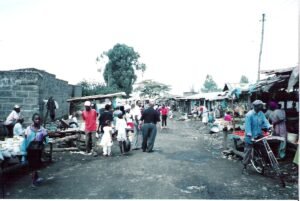Greater Things Ministries International
Kenya
Bringing Hope to Nakuru and Mayanja
 Nakuru, one of Kenya’s largest urban centers, is a melting pot of diverse tribal backgrounds and Indian communities. Unfortunately, the Church in Nakuru remains divided along tribal lines, with few integrated congregations.
Nakuru, one of Kenya’s largest urban centers, is a melting pot of diverse tribal backgrounds and Indian communities. Unfortunately, the Church in Nakuru remains divided along tribal lines, with few integrated congregations.
 Our outreach efforts in Nakuru have primarily been open-air evangelistic meetings, drawing people from all walks of life. During our first visit, the region had suffered a prolonged drought, with failed rainy seasons threatening the livelihoods of many. However, from the day we arrived, the rains came—each afternoon bringing much-needed relief before stopping just in time for our meetings to begin. As a sign of God’s faithfulness, rainbows—sometimes two—would form over the city.
Our outreach efforts in Nakuru have primarily been open-air evangelistic meetings, drawing people from all walks of life. During our first visit, the region had suffered a prolonged drought, with failed rainy seasons threatening the livelihoods of many. However, from the day we arrived, the rains came—each afternoon bringing much-needed relief before stopping just in time for our meetings to begin. As a sign of God’s faithfulness, rainbows—sometimes two—would form over the city.
Church Planting in Mayanja
 Mayanja, a farming community near Bungoma on the Ugandan border, was the site of one of our church plants. We strategically planned an outreach to coincide with the local market days, running from Tuesday through Saturday. By Sunday, we launched a new church with over 100 new believers.
Mayanja, a farming community near Bungoma on the Ugandan border, was the site of one of our church plants. We strategically planned an outreach to coincide with the local market days, running from Tuesday through Saturday. By Sunday, we launched a new church with over 100 new believers.
 In both Nakuru and Mayanja, we have also hosted leadership training seminars. The Mayanja sessions were especially meaningful, drawing pastors and church leaders from various denominations—some traveling long distances, including a few from Uganda. The impact of these teachings has extended far beyond the classroom. Many leaders have shared the material with others, spreading the message across regions. We have even received letters from over 100 miles away, where pastors were blessed by teachings passed on second- and third-hand.
In both Nakuru and Mayanja, we have also hosted leadership training seminars. The Mayanja sessions were especially meaningful, drawing pastors and church leaders from various denominations—some traveling long distances, including a few from Uganda. The impact of these teachings has extended far beyond the classroom. Many leaders have shared the material with others, spreading the message across regions. We have even received letters from over 100 miles away, where pastors were blessed by teachings passed on second- and third-hand.
The Clashes: A Nation in Turmoil
 Kenyans refer to the post-election violence of 2008 as “the clashes,” a tragic eruption of political ambition, tribal tension, and deep-seated grievances. When supporters of the ODM party protested what they believed to be a stolen election, violence escalated between rival tribes. Decades-old land disputes fueled the conflict, leading to widespread displacement and bloodshed.
Kenyans refer to the post-election violence of 2008 as “the clashes,” a tragic eruption of political ambition, tribal tension, and deep-seated grievances. When supporters of the ODM party protested what they believed to be a stolen election, violence escalated between rival tribes. Decades-old land disputes fueled the conflict, leading to widespread displacement and bloodshed.
 The official death toll was estimated at 1,200, though locals reported nearly 900 burials per day in Nakuru alone at the height of the violence. In total, 600,000 people were driven from their homes. One refugee shared heartbreaking words: “Why should I return to the land where the blood of my family still wets the ground?”
The official death toll was estimated at 1,200, though locals reported nearly 900 burials per day in Nakuru alone at the height of the violence. In total, 600,000 people were driven from their homes. One refugee shared heartbreaking words: “Why should I return to the land where the blood of my family still wets the ground?”
For ten days, I traveled the corridor from Nakuru to Bungoma—through the heart of the violence—bringing a message of hope to the churches.
Restoring Lives in IDP Camps
 In Nakuru, two major internally displaced persons (IDP) camps emerged. The Showground Camp sheltered 3,000 Kikuyu in 800 tents, while Afraha Stadium Camp housed nearly 1,600 Luo, Luhya, and Kisii in 205 tents.
In Nakuru, two major internally displaced persons (IDP) camps emerged. The Showground Camp sheltered 3,000 Kikuyu in 800 tents, while Afraha Stadium Camp housed nearly 1,600 Luo, Luhya, and Kisii in 205 tents.
 Thanks to the generosity of our friends and supporters, we were able to provide food, clothing, mattresses, and blankets to hundreds who had lost everything.
Thanks to the generosity of our friends and supporters, we were able to provide food, clothing, mattresses, and blankets to hundreds who had lost everything.
 The trauma was overwhelming. Young and old alike suffered from depression, fear, and anxiety, stripped of hope for the future. I spent time in local schools and with early childhood classes at the camps, offering comfort and encouragement to children who had seen more pain than anyone should endure.
The trauma was overwhelming. Young and old alike suffered from depression, fear, and anxiety, stripped of hope for the future. I spent time in local schools and with early childhood classes at the camps, offering comfort and encouragement to children who had seen more pain than anyone should endure.
A Mission of Hope
Though the wounds of the past run deep, our mission in Nakuru and Mayanja continues—to break down tribal barriers, restore lives, and spread the love of Christ. The challenges are great, but the power of unity and faith is greater.
